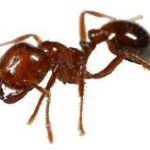 You may have been bitten by or know someone bitten by Fire Ants before. It may surprise some to know that not everyone survives the sting. In some people, it may cause an anaphylaxis reaction similar to that of a Bee sting.
You may have been bitten by or know someone bitten by Fire Ants before. It may surprise some to know that not everyone survives the sting. In some people, it may cause an anaphylaxis reaction similar to that of a Bee sting.The fire Ant is a member of the Wingless Hymenopter. When it bites, it grabs skin, and in circular pattern continues to sting with its abdominal stinger. The stinger pumps a water insoluble substance into the victim’s skin that in turn induce histamine and vasoactive amine from mast cells that could cause a fatal anaphylaxis reaction.
The most at risk population are the immobile patients, babies and drunk people who fall on Ant molds. Most deaths occur from anaphylaxis.
The degree of reaction varies. Typically a sterile pus forms at the sting site but  a wheal reaction could make the extremities swell and if severe, may cut off blood supply to the limbs.
a wheal reaction could make the extremities swell and if severe, may cut off blood supply to the limbs.
 a wheal reaction could make the extremities swell and if severe, may cut off blood supply to the limbs.
a wheal reaction could make the extremities swell and if severe, may cut off blood supply to the limbs.In more severe reactions to the sting, anaphylactic life threatening reactions may occur immediately but it may be delayed for hours too.
Inability to breath from bronchospasm or and laryngeal edema and swelling of the face and airway from angioedema are known to cause fatalities. Other serious signs/symptoms could include low blood pressure or seizures.
 SEE YOUR DOCTOR.
SEE YOUR DOCTOR.Cold Compresses, oral antihistamines, topical steroids, NSAIDS and Tetanus prophylaxis in some cases are possible treatment options your doctor could consider.
Your doctor may discharge you home if your reactions are minor but you may also be kept for observations if you have a systemic reaction. Your doctor will make that call.
Always carry an Epi-Pen with you and a Medic Alert Bracelet if you are allergic to the sting.
Finally, it may help to know that clothing with bright colors, strong perfumes attract fire ants.